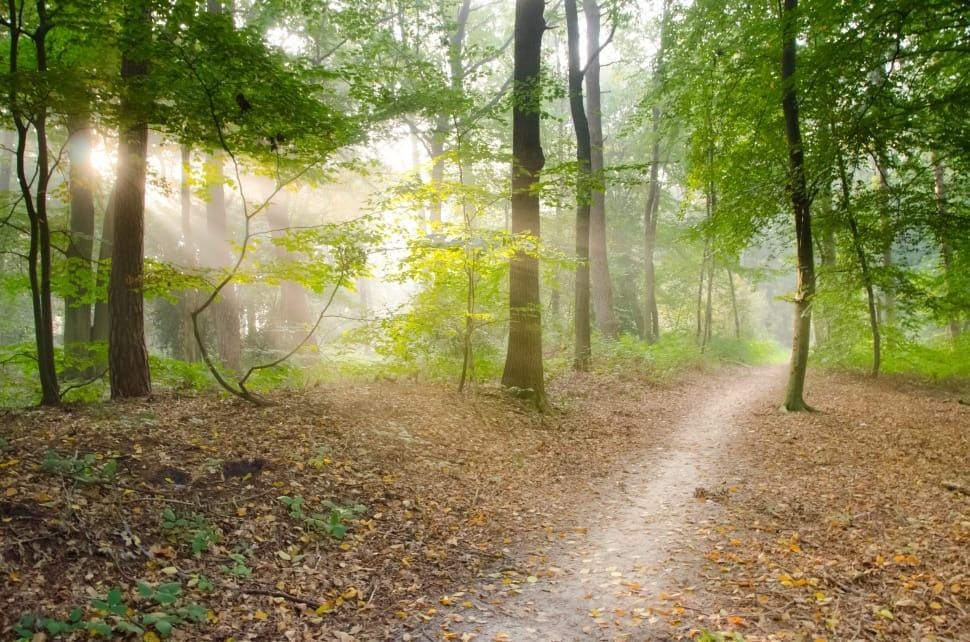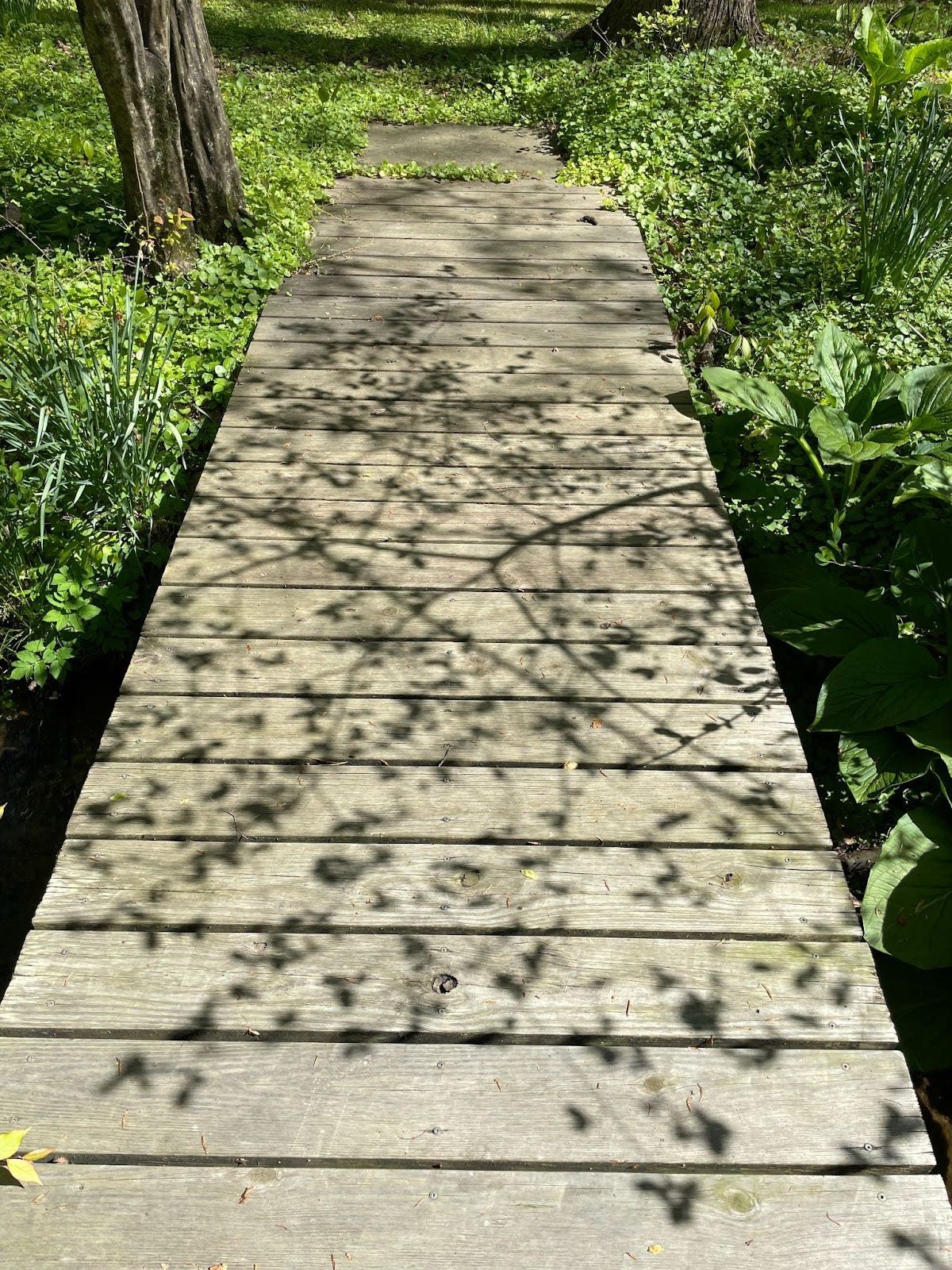Balms of Nature: Shinrin-Yoku and Seaside Saunters
The Well Canto Newsletter - Ponder This May 3, 2024 Volume 13
Hello, Lovely Singers and all Creatives!
Calm your soul, tune your brain, and energize your body? YAS!
Common sense and science combine to impel us to get out into beautiful, healing nature - YAY!
Shinrin-yoku
Imagine yourself walking amongst trees, not in a hurry, mind at ease. You listen to all the sounds around you: the breeze in the canopy, the crunch under your feet, birds calling, perhaps a murmuring stream nearby. You notice soft browns and grays, glimpses of blue sky, and every hue of green encircling you. You breathe in deeply and out slowly, accepting what nature offers, comfortably aware you are an element of your surroundings. You feel your stress dissolve and your gratitude increase.
Although the term Shinrin-yoku, or Forest Bathing, is only a few decades old, the benefits of connecting to nature are nothing new. We crave a close link with other life, which makes sense since as a species we have spent 99% of our existence closely tied to our natural surroundings. Research is catching up with our inner wisdom by showing that people who regularly spend time in nature are happier and feel more satisfied with life. Lingering in a natural setting generates positive emotions, and decreases anxiety and depression.
Coined in 1982 by Japan's Ministry of Agriculture, Forestry, and Fisheries, Shinrin-yoku has deep roots in Japan's Buddhist and Shinto traditions. Most literally translated as “being in the atmosphere of the forest”, it is based on three traditional Japanese concepts:
Yūgen - being so keenly aware of the beauty of the world around you that the deep emotions you feel cannot be expressed with words.
Komorebi - literally translates to “sunlight leaking through trees”, it describes the relationship, or interplay, between the sun and the leaves.
Wabi sabi - celebrates the beauty of imperfection and impermanence.
Does this sound like mindfulness to you? I have to agree. But why trees? Trees release oxygen and phytoncides into the air. Breathing in the compounds reduces stress hormones, and enhances our immune system by increasing levels of white-blood cells known as natural killer cells. Our brains love nature, too. Research measuring brain activity during nature exposure indicated increased focus, cognitive flexibility, and creativity. Further, signals of fear and threat were lowered in the amygdala, and decreased blood-flow in the prefrontal cortex was associated with a decrease in rumination.
Research measuring brain activity during nature exposure indicated increased focus, cognitive flexibility, and creativity.
Drenching oneself in the forest vibe encourages a deep present-moment experience, calming our brain activity, setting the stage for our minds to open to gratitude, optimism, and compassion.
Beauty everywhere
LISTEN (1:49): Franz Schubert: Der Jüngling an der Quelle (Elly Ameling, Jörg Demus, 1965)
The Youth by the Spring
English translation © Richard Wigmore
Softly rippling brook,
swaying, whispering poplars,
your slumbrous murmur
awakens only love.
I sought consolation in you,
wishing to forget her, she who is so aloof.
But alas, the leaves and the brook
sigh for you, Louise!
Green Spaces
So, what if you don’t live near an ancient forest or even a woodsy trail? With half the world’s population living in urban environments, access to high quality green spaces is vital: city dwellers are 21% more likely to develop an anxiety disorder, and 39% more likely to develop a mood disorder than non-city dwellers.
What is a Green Space? It is any protected area of undeveloped landscape like a field or forest, a park or garden, which contains plenty of foliage. What makes a Green Space high quality is that it is maintained, clean, quiet, spacious, and safe. Just 30 minutes a week spent in green spaces can lead to a reduction in depression symptoms. However, low-income communities have far less access to high quality green spaces, reflected in life-expectancies 10 years lower than their affluent neighbors. Developing and maintaining green spaces in all city areas could effectively promote well-being of the overall population!
Just 30 minutes a week spent in green spaces can lead to a reduction in depression symptoms.
To get the most from your ‘nature therapy’, remember to approach it contemplatively: go slowly, breathe deeply, and engage your senses. Feel your body in the space around you and let your thoughts fall away.
Blue Spaces
Blue Spaces, as one might surmise, are accessible outdoor spaces that predominantly feature water. They can be natural - like lakes, rivers, or the beach - or man-made, such as fountains, water-gardens, or pools. The sounds, colors, textures, and sights may differ from Green Spaces, but both scenarios enhance well-being in a number of ways.
The morning after my Mom passed away just a few weeks ago, I found myself walking on Sand Key. In the odd daze of reality-shifting loss, I didn’t recall deciding to go to the beach. I unconsciously skipped the nearest beach in favor of another that held the most specific, happy memories. I walked at least two hours that first morning, not fully able to form thoughts. I simply kept moving and feeling, comforted by the so-familiar sounds and scents, as if my body knew what my heart needed. For each of the next 10 mornings that I remained in my hometown, I walked that beach for hours; a balm that helped ameliorate the crushing tasks and onslaught of emotion to follow.
It turns out that sea air contains ions that facilitate the creation of new neural pathways, and boosts electrical functionality of the brain by 47%! That is a good thing - well-operating brains enable us to think, feel, and interact with the world. Sea air also has higher levels of oxygen, which improves all functions of the body, like hormone production, digestion, tissue renewal, and muscle contraction, to name a few. Of course, judicious exposure to natural light also boosts physical and mental well-being. And did you know that wiggling your piggies in the sand actually decreases inflammation in the body and brain?
My toes, Sand Key, and the Gulf of Mexico
LISTEN (3:37): Kokomo
DIY Green Spaces and Blue Spaces
More good news! You can reap some of the benefits of green and blue spaces by bringing them to you. Open your windows to let in fresh air and bird songs, or spend your indoor time near an unshaded window, taking in the view. Potted plants are a great way to bring nature in, with the added benefit of caring for other living things. How about a table-top water feature? Incredibly, research also shows that simply viewing nature videos or still photography can also improve health and happiness.
Check this out! Make sure to use the 360° option in the upper left corner:
WATCH (6:09): Virtual Nature 360° - Nature Meditation for VR Quest
Let’s review some of the powerful benefits of connecting to nature:
Supports Health
Reduces nervous system arousal
Lowers blood pressure
Decreases stress hormone levels
Supports oxygenation of blood
Enhances immune system function
Encourages physical activity
Soothes and Energizes
Boosts brain function
Reduces anxiety and depression
Decreases rumination and worry
Improves mood
Increases ability to focus
Supports better and longer sleep
Connects to Others
Increases sense of unity and belonging
Decreases violence and aggression
Improves coping skills
And just feels nice.
Post Script
Just now during a Shinrin-yoku, a warm spring storm passed overhead. I heard the rain on the trail before I felt it, and watched the light around me darken. Rather than follow my first impulse to dash away, I accepted the unexpected as a gift that enhanced my solitude. I noticed how cleansed the air smelled while thunder rumbled in the background. The sights, sounds, and sensations of getting caught in the rain was my healing balm of the day.
What is your favorite way to immerse in nature?
How would you describe your state of mind before and after?
May you live in kindness and ease, with a free heart.











Wonderful as always! ❤️